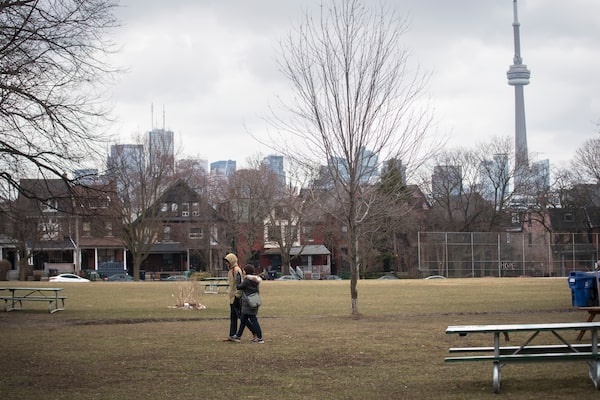
Trinity Bellwoods Park in Toronto's west end, on March 17, 2020.Fred Lum/The Globe and Mail
Every afternoon around 3, I try to get out of my home office and go for a walk. Each time I do, I marvel at how my neighbourhood has changed.
I live in the west end of downtown Toronto, near the intersection of Dundas and Dufferin streets. It is usually known as Little Portugal, though real estate agents have taken to calling my patch “Beaconsfield Village.” Queen Street West is at the bottom of my street and Dundas Street West at the top. The buzzing Ossington Strip is just a few blocks away. A few steps farther is Trinity Bellwoods Park, where the young gather to sprawl on the grass on summer weekends.
When we moved here in 1989, no one would have called it a fashionable part of town. After I told my father what we had paid for our 16-foot-wide, 100-year-old, semi-detached house he helpfully remarked: “A quarter of a million for a place in a slum?”
Our part of Dundas was an uninviting stretch of auto-repair shops, shady karaoke bars and old-fashioned menswear stores that no one ever seemed to shop in. Queen was known for its greasy spoons and used-appliance stores crammed with beat-up fridges and stoves. The Drake Hotel at 1150 Queen West was a dubious establishment with a bar called the Stardust Lounge.
That is ancient history now. The Drake was renovated and reopened years ago, becoming the beachhead for a hipster invasion that has turned my ‘hood into one of the hottest in Toronto. People come from all over town to visit its drinks bars, coffee bars, clubs, restaurants and boutiques, now stirring back to life as pandemic fears ease. Local house prices have gone from crazy to stupid to obscene. A little two-storey semi on the next street over is on sale for $1.9-million. So there is plenty of change to take in.
I start my walk by heading south to Queen, passing lots of houses under renovation and a few sporting “For Sale” signs, one of them from Sotheby’s, no less. Then I turn east to head along Queen, passing the Drake, turn north on Ossington and then back west along Dundas. On the way I pass galleries, bistros, nail salons, hair salons, a sourdough bakery, a chocolaterie, a croissanterie, a Cuban-food joint, an Israeli/Palestinian food joint, way too many cannabis shops and several of those carefully curated, minimally stocked clothing shops that bring to mind the Portlandia episode Two Girls, Two Shirts.
Sometimes it all seems a bit much. The local craft brewery offers an IPA, Ghost Orchid, named after ”the coveted but endangered flower” and featuring notes of mandarin orange, white grape and pine. A sweets shop makes themed pastries for fans of Harry Potter, Star Wars and other cultural phenomena. “We believe in magic, adventures, and Love is Love is Love,” its website declares.
On the other hand, sweets are good. Fun is good. People are good: they are thronging the once-grey streets again, meeting, shopping, drinking or just promenading. What is sneeringly referred to as gentrification often brings money and action to rundown parts of old cities. Some locals have cashed out their real estate winnings and moved on. Others, like several of my Portuguese neighbours, have stayed, no doubt shaking their heads at all the change but deciding to live out their old age where they are most comfortable.
Not all of the ‘hood’s old character is lost. We have two thriving Portuguese butchers around the corner from us, along with a hardware store, a car mechanic, a couple of old-style barbers where a haircut doesn’t cost the earth and a pair of corner stores that carry everything from soft, freshly baked Portuguese buns to mangos from Asia to charge cords for your phone.
As remarkable as what has disappeared is what hasn’t. Several little travel agencies cling to life, who knows how? Incredibly, a coin laundry survives on Ossington amid the wine bars. So does a cigar manufacturer and two self storage places, though a big hardware store has now closed. That museum-like menswear place that nobody ever entered is still there on Dundas – and still nobody goes in.
It would be obtuse to suggest there have been no downsides to this great transformation. People of average means have been priced out. My kids say they can’t imagine being able to buy a house like the one where they grew up. The divides between rich and poor are starker, with more obviously wealthy people around and more vulnerable people, too, some of them panhandling on the sidewalks as the scene passes.
But much of the change has been for the good. The area has greater variety now, greater vitality. There are more people around, many of them living in the host of mid-rise condos that have risen on or near the main streets. It feels like a place that is surging forward instead of standing still.
Cities change, neighbourhoods change, times change. I can’t imagine what I’ll see on my daily walk 10 years from now.
Our Morning Update and Evening Update newsletters are written by Globe editors, giving you a concise summary of the day’s most important headlines. Sign up today.
 Marcus Gee
Marcus Gee